
© Railway Wonders of the World 2012-


How Our Railways Convey Invalids
The Invalid Carriages of the Main Railways
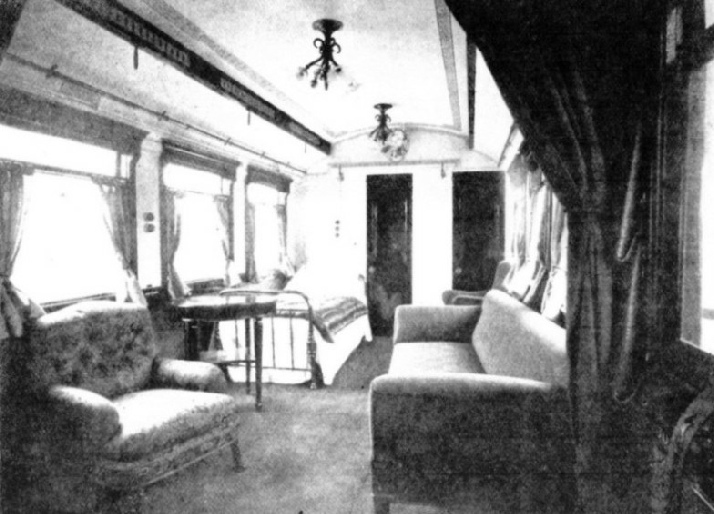
GREAT NORTHERN RAILWAY
Interior of new invalid carriage, showing bedstead with bedrest.
OUR railways make it their business to cater in an adequate and complete manner for every class of traveller. There is one class of passenger, not very common perhaps, however, which has not, to the writer’s knowledge ever formed the subject of an article, so he proposes to throw some light on the facilities offered to a little known class of passenger.
The class referred to is one to whom ordinary rolling stock is almost if not totally useless, who must be dealt with in a similar manner to a piece of frail china, to wit, the Invalid. Up to comparatively recent times the facilities offered to sick people for getting from place to place were very limited, and precluded those who were unable to bear the oscillation of the train over facing points and when negotiating curves, from taking advantage of them.
A few lines dispose of them: a couch, or wheeled chair in the guard’s van, pillows in a third class compartment, and an upholstered stool made to fit between the seats in a first class and form a sort of bed, about sum up the total, and it does not require a very vivid imagination to conjure up a picture of the nerve-
The state of things depicted at some length above is almost a thing of the past, and the railways which expect to include invalids amongst their patrons are now all turning their attention to arrangements that alleviate the inconvenience of invalid travel.
Some railways, from one cause or another, have not introduced these facilities for invalid travel. Take for instance the Highland Railway of Scotland, whose clientele principally includes sportsmen and tourists, the invalid being a rara avis.
The Great Northern Railway has recently constructed at its Doncaster works a new vehicle which can be used either, as a family, parlour, or an invalid saloon.
The carriage, which is built with a high elliptical roof, is 50 ft. long by 9 ft. wide, and is carried on four two-
The family or invalid compartment is placed in the middle of the vehicle so as to be well clear of the bogies and ensure easy riding. It is furnished with an invalid bed fitted with a bed rest, which is removed when not required, a couch, three easy chairs, one portable table and two flap tables. The floor is covered with crimson Wilton pile carpets over the top of a layer of felt one inch in thickness, the furniture is upholstered in blue and green tapestry. Double doors are provided on each side of the invalid compartment four feet wide, so that ample room is provided for the invalid to be carried. When not in use these doors are covered by two heavy curtains made of green and gold tapestry.
Adjoining the invalid compartment is a large toilet compartment, fitted with every convenience. The two corridor compartments are upholstered in Blenheim Moquette, and are made convertible, to be used for either day or night service, giving accommodation for four persons in each compartment for day service or converting into double sleeping berths for night service.
A sink and hot water boiler are provided in the corridor for the use of the attendant, and a compartment is provided at one end for luggage.
The regulations regarding the availability of this sumptuous and luxurious coach will be dealt with at the end, as most of the railways have the same set of rules.
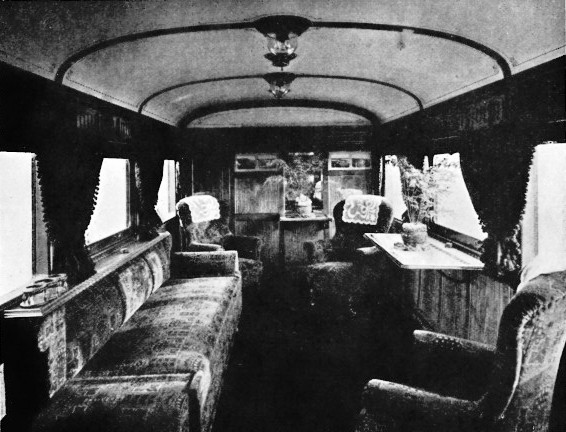
LONDON AND SOUTH-
Interior of invalid saloon.
The London and South-
The saloon and first class compartments are finished in polished wainscot oak, with satinwood panels, and the upholstery is of handsome figured moquette with a groundwork of old gold colour, and the carpets, curtains and blinds have been carefully selected to harmonise therewith.
The attendants’ compartment, as well as the lavatory and corridor, are finished in polished mahogany with light plywood planks, and the sanitary fittings are of Doulton’s decorated white ware and St. Anne’s marble. Where possible, polished woodwork has taken the place of padding and upholstery, and everything tending to harbour dust and dirt has been eliminated without in any way detracting from the pleasing and comfortable appearance of the interior arrangements.
In the conveyance of invalids it is most desirable that such facilities should be given that they may make the whole journey with as little personal change of position as possible, and, if practicable, be carried on the same stretcher bed throughout, and this principle is now generally adopted by the “Ambulance Associations”. To meet these requirements the new saloons have been specially fitted with convertible couches of unique and serviceable design. When the saloons are used for family or private parties, these coaches appear of the ordinary type, but by a single mechanical contrivance they may, in a few moments, be converted ready to receive a stretcher bed. The back of the couch slides into a recess, and the ends move to any desired position, leaving the seat quite clear for the reception of a stretcher, or should the invalid be able to recline on the couch, he may rest at any angle and with his face or back to the direction in which the train is going, as preferred.
The vehicles are fitted with the latest arrangement of steam heating, which is directly under the control of the passengers, and with Stone’s system of electric lighting embodying the latest improvements, and so arranged that the lamps may be controlled by the passengers inside as desired, and electric bells are also fitted to call the attendants.
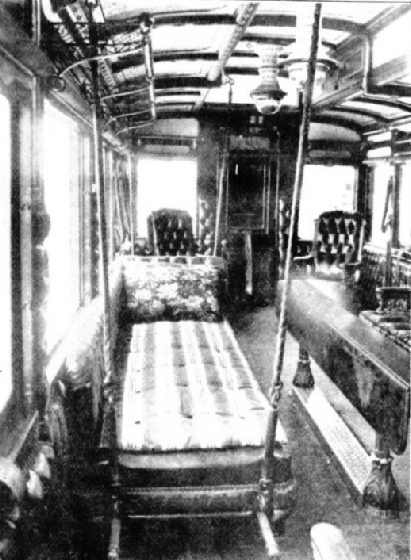 The greatest possible care has been taken to ensure smooth, easy and quiet running, every precaution having been taken to avoid shocks and jars in passing over points and crossings.
The greatest possible care has been taken to ensure smooth, easy and quiet running, every precaution having been taken to avoid shocks and jars in passing over points and crossings.
GREAT WESTERN RAILWAY
Interior of Invalid Carriage, showing suspended couch.
The Great Western Railway one naturally expects to be down to date, and as regards its provision for invalids no disappointment is experienced.
In addition to the fittings, which it provides in common with other railways, a coach is provided, hung from the roof by suspension slings, fitted with springs to eliminate vibration, whilst to facilitate removal the invalid couch is provided with sliding handles and the saloon has double doors. A small gas ring and hot plate are provided in the brake compartment for refreshment purposes.
The specifications of this vehicle are as follows:-
Entrance is effected by means of large double doors, which give access to the main saloon. Immediately on the right are two large easy chairs with table between. On the left are two couches running parallel with the metals, with a flap table in between. The first of these couches is replaced by the suspended couch as necessity arises. At the end of this compartment is another couch, at right angles to the others. From this saloon we enter a corridor and pass in turn the lavatory, compartment for attendants, and finally reach the luggage part which in turn leads to the guard’s quarters.
Travel where you will, it would be a difficult matter to find any vehicle in which the comfort of the invalid is more studied than in those provided by the Great Western Railway.
On the London and North-
The invalid compartment is nearly in the centre of the saloon, and is over 18 feet long. It is fitted with an ornamental gold lacquered bedstead, with a box mattress and a hair mattress on the top. At the head and foot of the bedstead are easy chairs trimmed with green Blenheim Moquette to match the couch opposite the bed. The couch is of large dimensions, to enable an invalid to recline on it when desired. On either side of the saloon, at one end of the invalid compartment, double folding doors are provided wide enough to lift a bath chair through without disturbing the occupant. The chair can be taken with ease up to the side of the bed or couch and an invalid transferred to either.
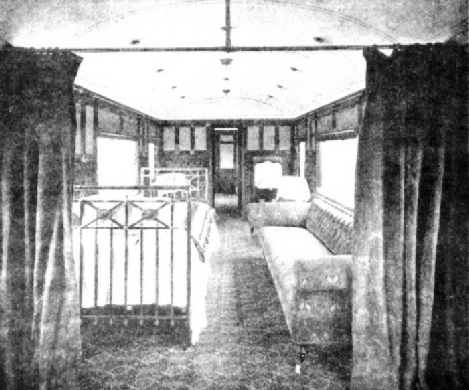
LONDON AND NORTH-
Interior of Invalid Carriage, showing bedstead and curtains.
At the head of the bed curtains are hung to screen the bed from any draught from that end of the compartment. These curtains are in green tapestry, and can be fastened together at the centre or drawn to the side. At the opposite end of the compartment a silvered lavatory washbasin with all requisites is provided. This is in cabinet form and supplied with water from an overhead tank in the adjacent lavatory. The floor is covered with a thick Wilton pile carpet to harmonise with the rest of the upholstery. This is laid on thick grey felt, which also serves to deaden the sound and take up vibration, thus making the compartment very quiet and still whilst running.
A serving table is provided at the foot of the bedstead. Next to this compartment are two lavatories, with hot and cold water supply, with a passage between leading into a first class compartment. An electric kettle is fitted to the lavatory for supplying hot water for tea, coffee, etc.
Two first class compartments are at opposite ends of the saloons, both leading out of the large compartment.
Four chairs are arranged to draw out to meet at the centre, forming a bed when required. The blinds throughout are of Holbein gold tapestry, mounted in blind hoods, and are adjustable. The saloons are electrically lighted on Stone’s system by lights in the roof. The lights have opal and tinted glass shades and are controlled by switches in the compartment. In the invalid compartment a special subdued light switch is fitted.
The ventilation is on the torpedo principle with torpedoes in the centre of the roof, and side ventilation over the door. Electric fans are also provided in the saloon compartment.
The saloons are heated on the consolidated steam heating system, the heaters being placed under the chairs, couches, etc., and controlled by valves which can be operated by the passengers. They are also fitted with the combined automatic vacuum and Westinghouse breaks and passenger communication between driver and guard.
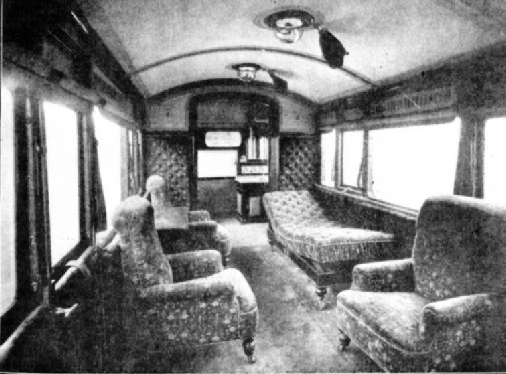
LONDON, BRIGHTON AND SOUTH COAST RAILWAY
Interior of Rail Invalid Carriage, showing adjustable couch.
On the South-
In addition to the above the Managing Committee of the South-
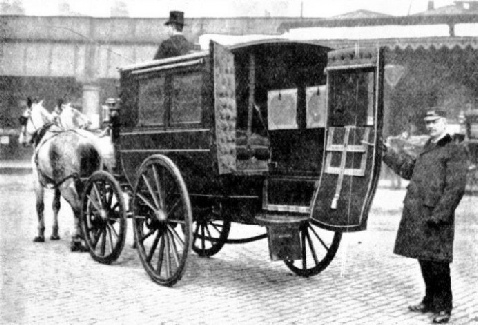
LONDON, BRIGHTON AND SOUTH COAST RAILWAY
Road and Rail Invalid Carriage, horsed for conveying invalid between residence and railway station.
On the London, Brighton and South Coast Railway the arrangements are almost identical with those on the South-
We mentioned a short time ago that the scale of charges for the use of these vehicles was very much the same on all railways.
As a general rule four first class and four third class tickets are sufficient to secure the use of an invalid’s coach.
The Great Western Railway require six first class tickets.
The South-
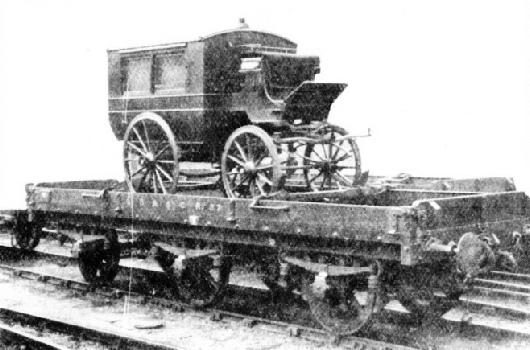
LONDON, BRIGHTON AND SOUTH COAST RAILWAY
Road and Rail Invalid Carriage mounted on truck for conveyance by train.
You can read more on “Modern Passenger Rolling Stock”, “The Railway Takes All” and “Rolling Stock Construction” on this website.